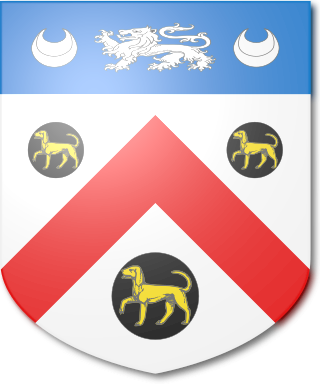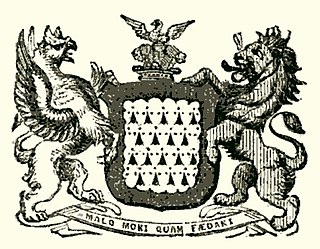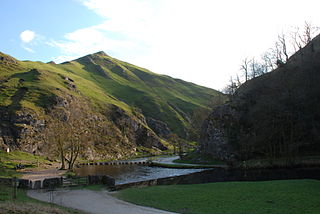Related Research Articles

Thomas FitzGerald, 10th Earl of Kildare, also known as Silken Thomas, was a leading figure in 16th-century Irish history.

Sir Thomas Allen, 1st Baronet was the eldest son of John Alen of St. Wolstan's, near Celbridge, County Kildare and Anne, daughter of Thomas Dillon of Riverstown, County Meath. He was the grandnephew of John Alan, Lord Chancellor of Ireland, who acquired St Wolstan's on the dissolution of the monasteries.
John Alen was an English priest and canon lawyer, whose later years were spent in Ireland. He held office as Archbishop of Dublin and Lord Chancellor of Ireland, and was a member of the Privy Council of Ireland. In the latter office, for a few years, he played a central role in the government of Ireland.
Sir Gerald Aylmer was an Irish judge in the time of Henry VIII, who played a key part in enforcing the Dissolution of the Monasteries. His numerous descendants included the Barons Aylmer.

John Barnewall, 3rd Baron Trimleston, was an Irish nobleman, judge and politician. He was the eldest son of Christopher Barnewall, 2nd Baron Trimlestown and his wife Elizabeth Plunket, daughter of Sir Thomas Fitz-Christopher Plunket of Rathmore, Lord Chief Justice of the King's Bench in Ireland and his second wife Marian Cruise. He succeeded his father as 3rd Baron in about 1513. His father, like most of the Anglo-Irish aristocracy, had supported the claim of the pretender Lambert Simnel to the English throne in 1487. After the failure of Simnel's rebellion, he received a royal pardon.
Robert St Lawrence, 3rd Baron Howth was a leading nobleman and statesman in 15th-century Ireland who held the office of Lord Chancellor of Ireland. Through his second marriage, he was a close connection to the new Tudor dynasty, to which his son was staunchly loyal.
Nicholas St Lawrence, 4th Baron Howth was a leading Irish nobleman, soldier and statesman of the early Tudor period, who held the office of Lord Chancellor of Ireland.
Patrick Finglas was a leading Irish judge and statesman of the sixteenth century, who was regarded as a mainstay of the English Crown in Ireland. He was also the author of an influential "Breviat", or tract, called Of the Getting of Ireland, and of the Decay of the same, concerning the decline of English power in Ireland.
Walter Fitzsimon or Fitzsimons was a statesman and cleric in Ireland in the reign of Henry VII, who held the offices of Archbishop of Dublin and Lord Chancellor of Ireland.
Sir John Alan was a leading English-born statesman in sixteenth century Ireland. He was a member of the Irish House of Commons, and held the offices of Master of the Rolls in Ireland, Chancellor of the Exchequer of Ireland and Lord Chancellor of Ireland. Though he was childless himself, one of his brothers, William, founded a prominent landowning dynasty in County Kildare. The family's holdings included lands at Celbridge, St. Wolstan's and Kilteel, County Kildare, as well as substantial lands in County Dublin. They also acquired a baronetcy.
Christopher St Lawrence, 5th Baron Howth (c.1485–1542) was an Anglo-Irish nobleman and statesman of the Tudor era.
Richard St Lawrence, 7th Baron Howth was an Anglo-Irish nobleman and military commander of the Tudor era.
Richard Delahide was an Irish judge of the sixteenth century, who held the offices of Chief Justice of the Irish Common Pleas and Chief Baron of the Irish Exchequer. His career was seriously damaged by the Rebellion of Silken Thomas, in which several members of his family played a leading part, and he was fortunate to escape permanent disgrace.
Christopher St Lawrence, 2nd Baron Howth was an Anglo-Irish nobleman. He was a key figure in fifteenth-century Irish politics, and one of the strongest supporters in Ireland of the House of York, who seized the English Crown in 1461. His tomb can still be seen in the family chapel in St. Mary's Church, Howth.
Patrick Bermingham (c.1460–1532) was an Irish judge and statesman of the Tudor period who held the offices of Lord Chief Justice of Ireland and Chancellor of the Exchequer of Ireland. He was a firm supporter of English rule in Ireland and enjoyed the confidence of Henry VIII, who regarded him as a mainstay of the Irish administration.
Robert de Holywood was an Irish judge and landowner who held the office of Chief Baron of the Irish Exchequer. He was the ancestor of the Holywood family of Artane Castle, and of the St. Lawrence family, Earls of Howth. He was a substantial landowner with property in Dublin, Meath and Louth. He became extremely unpopular, and was removed from office after numerous complaints of "oppression and extortion" were made against him. These were apparently inspired ĺargely by his close association in the mid-1370s with Sir William de Windsor, the embattled Lord Lieutenant of Ireland.
Sir William Darcy (c.1460–1540) was a leading Anglo-Irish statesman of the Pale in the early sixteenth century; for many years he held the office of Vice-Treasurer of Ireland. He wrote an influential treatise, The Decay of Ireland, which led to his being called "the father of the movement for political reformation in Ireland". He was a colourful and flamboyant character, whose exceptional height gave rise to his nickname "Great Darcy".
Robert Preston, 1st Baron Gormanston was an Anglo-Irish nobleman, statesman and judge of the fourteenth century. He held several senior judicial offices including, for a brief period, that of Lord Chancellor of Ireland. He was the founder of the leading Anglo-Irish Preston family whose titles included Viscount Gormanston and Viscount Tara.

Thomas Dowdall, also spelt Dowdale, Douedall, or Dowedall, was an Irish barrister and judge who held the office of Master of the Rolls in Ireland.
William St Lawrence, 2nd Earl of Howth was an Anglo-Irish peer, styled Viscount St Lawrence from 1767 to 1801.
References
- ↑ Pine, L.G. The New Extinct Peerages 1884–1971 192 p.150
- 1 2 3 4 5 6 Ball, F. Elrington The Judges in Ireland 1221–1921 1926 John Murray London Vol.1 p.202
- ↑ Ball, F. Elrington History of Dublin Vol.5 1917 Alexander Thom and Co. Dublin p.63
- ↑ Ball 1917 p.64
- ↑ Ball 1926 p.129
- ↑ Kenny, Colum King's Inns and the Kingdom of Ireland Irish Academic Press Dublin 1992 p.33
- ↑ Ball 1926 p.130